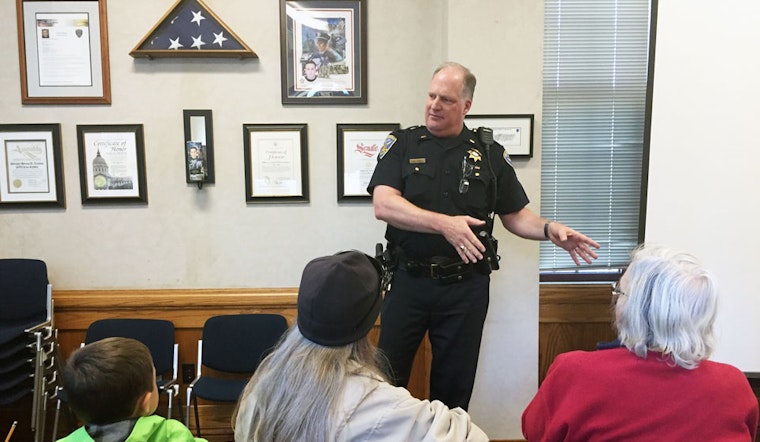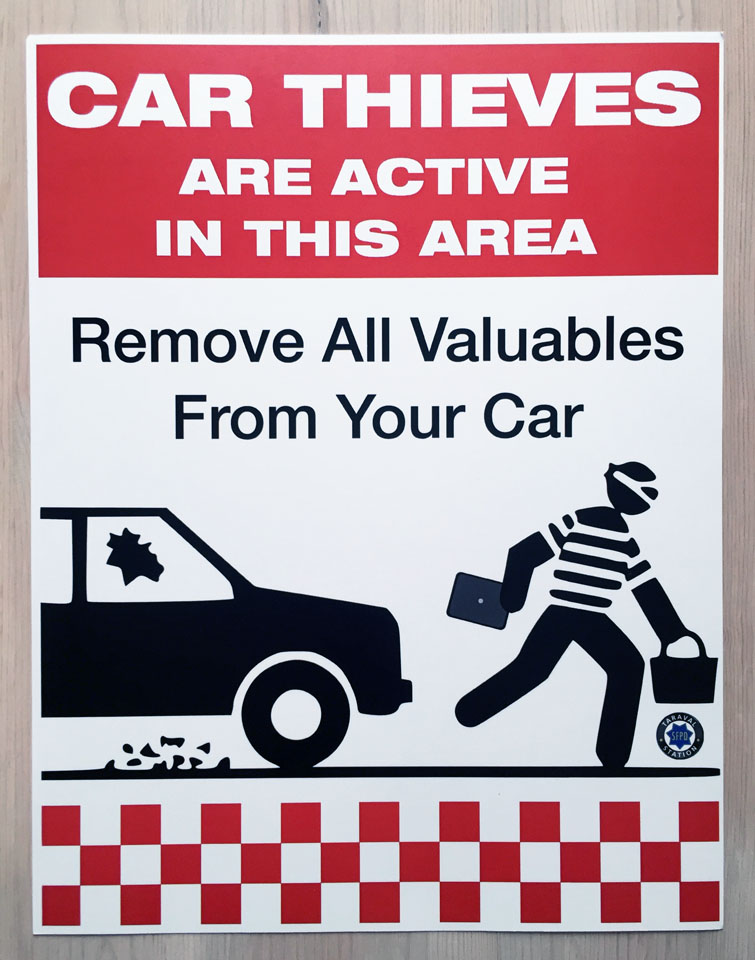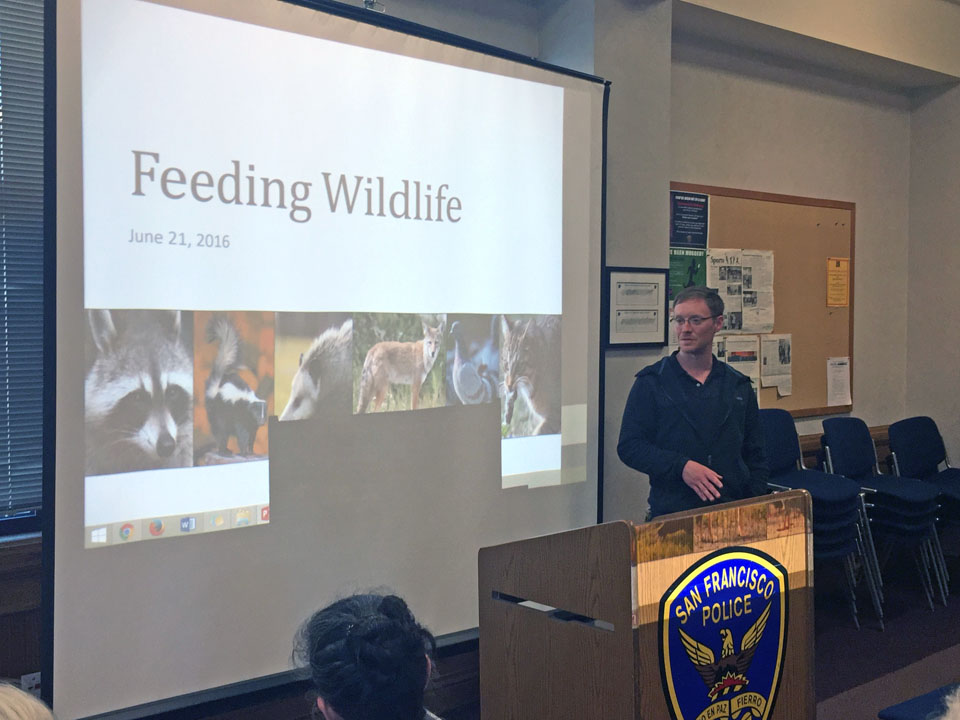
This week, SFPD Taraval Station held its first public safety community meeting in three months—due to a change instituted by the station's captain, Denise Flaherty, who shifted the meetings from monthly to quarterly.
At the meeting, Lieutenant Richard Goss apprised attendees of the district’s current crime statistics, while District 4 Supervisor Katy Tang provided a couple of community updates. The Department of Public Health also gave a presentation on the dangers of feeding wildlife.
Goss began the meeting by acknowledging some community members' concerns about reducing the frequency of meetings. He argued that having less frequent meetings would bring in a wider range of attendees, and allow each meeting to have more of an impact. “[Flaherty] wanted to be able to reach out to a broader group of people ... she felt having meetings every month tended to dilute some of the message that was going out.”
Now, Goss said, the station will be able to provide a detailed, wide-ranging update at each meeting, instead of simply repeating information that was “essentially the same” each month. “Now we can give out information that’s a little more comprehensive; we can cover three to four months at a time, and give you the update as to what’s going on in the district.”
From there, Goss moved on to the crime stats for the district, noting that crime numbers are down in general, though not across the board. Overall, "Taraval is enjoying a pretty good run right now,” he said.
In the last three months, robbery numbers have been reduced to 14, 13 and 11 reported incidents, respectively—lower than the previous average of 19 per month. Goss said he was encouraged by the decrease in these types of crimes, which usually involve a victim at the scene and are perpetrated by “force or fear or some kind of violence."
Property crimes also are down from the start of the year: thefts from vehicles exceeded 200 for the months of December and January, but fell to 117 in April and 112 in May. (June numbers were not yet available.)
"[Thefts] nearly dropped by 50 percent, which we’re very excited about," Goss said, though he noted they're "still a huge problem." He also doesn't “anticipate this [decrease] lasting all summer,” due to the summertime increase in tourists.
To help prevent thefts, Vi Huynh, a member of the Taraval Community Police Advisory Board, presented a template caution sign that the board hopes to implement in area neighborhoods. The signs, in black, white and red, are different than those produced by SF Public Works, which can be “very mono-color … and kind of blend in with what is already there," Huynh said. They advise that “car thieves are active in this area," and encourage visitors to remove all valuables from their vehicles.

The advisory board has already approached SF State campus police, Park Merced Resident Services and Stonestown about implementing the signage; Huynh said they were all very interested.
Huynh said the group would be tracking the current stats for vehicle break-ins, and hope to track the efficacy of the signs that way. “We’re doing the neighborhoods section by section, basing it on data … we go and hit the areas that [have] the most crime, and that way we can measure the effects of the signs,” he said.
Goss thanked the board for its work on the signs. “This is the kind of thing that the community can do that the police department is necessarily unable to do, so we appreciate your efforts."
From there, Goss moved to discussing burglaries, which "tend to be fairly consistent throughout the district,” he said. Previously, the number of residential and commercial burglaries was at 29, but in May, it increased to 40.
Even with the increase, “those numbers are relatively very low,” considering they amount to approximately one burglary a day in an area that comprises 23 percent of the city. Nonetheless, "they’re still too high for us,” Goss said, adding that the June stats would likely be similar to May’s numbers. He told the group that the station has six plainclothes officers and a sergeant who are focused on preventing and solving these types of crimes.
Goss then handed the floor to Supervisor Tang, who revealed that the mayor has just announced that he’s going to start a citywide Public Safety Advisory Board. “The idea is to create another authentic, community-based entity to help with our public safety issues,” Tang said.
Each Supervisor will be allowed to appoint one person to serve on the board, with the mayor appointing at least one person as well. Though the legislation to create this body has not been passed yet, Tang advised those interested in serving to email her at [email protected].
Tang also noted that one of her colleagues on the budget committee, Supervisor John Avalos, has presented a proposal to place “$200 million of the police department’s $500 million budget on reserve, until reform measures are implemented” and results are seen.
Tang does not support Avalos' proposal, explaining that the city has already been struggling to meet its charter mandate of having no fewer than 1,971 full-duty officers. “We are finally about to reach that goal; in fact, the mayor put in more money so we could reach that goal one year earlier," Tang said.
While she's heard requests from constituents for better community policing and more officers present on the streets, "we can’t do that if we don’t have money. I think it’s very disingenuous to ask so many things of the police department and then … hold their budget hostage for it.”
Two speakers from the Department of Public Health, Patrick Wood and Carolyn Lam, closed out the evening with a presentation on the dangers of feeding wildlife. The talk focused on how feeding wildlife, either deliberately or inadvertently, can create problems, ranging from aggressive behaviors to disease and parasite infestations.

Here are a few of the DPH's suggestions to help avoid the problems that can come with feeding wildlife:
- Never intentionally feed wild animals, as this can cause crowding and allow diseases to spread.
- Avoid discarding food on the ground outside.
- Do not let your garbage cans overflow, which can create easy access for animals.
- Pick up fallen fruit in your backyard. Fallen, rotting fruit becomes a food source for wild animals.
- Always keep pet food bowls inside.
- Put all compostables in the green bin. You can further eliminate odor, which is a major attractant for animals, by wrapping food waste in newspaper or putting it in a paper milk carton before placing it in the green bin.
Lam advised that if you’re interested in composting on your own, Recology has information on how to do so properly.









